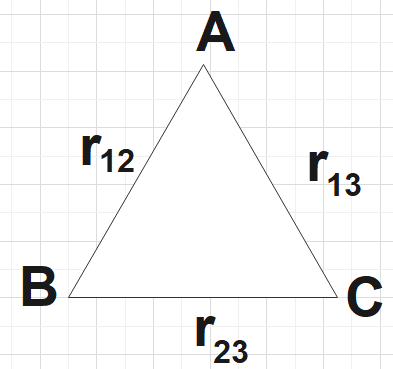Question
Question: Define electrostatic potential at a point. Write its SI unit. Three charges \({{q}_{1}}\),\({{q}_{2}...
Define electrostatic potential at a point. Write its SI unit. Three charges q1,q2 and q3 are kept respectively at points A, B and C as shown in figures. Write the expression for electrostatic potential energy of the system.

Solution
You could first recall the definition and also the SI unit for electrostatic potential and then give the answer to that part. Then, you could recall the expression work done to bring charge to an arbitrary point and then work accordingly and hence find the answer, that is the net potential energy of the system.
Formula used:
Work done,
w=qV=4πε01r12q1q2
Complete answer:
In the question we are asked to define electrostatic potential at a point and give its SI unit. We are also given a system that contains three charges at the corners of a triangle and we are asked to find the system’s potential energy.
We could define potential energy at a point as the work done so as to bring a unit positive charge from infinity to some arbitrary point of consideration. The SI unit of electrostatic potential is known to be Volt. Let the position vectors of charges q1,q2and q3ber1,r2and r3respectively. Let the work done to bring q1to r1be zero, then the work done to bring q2to r2be,
w2=q2V1(r2)=4πε01r12q1q2…………………………………… (1)
Now the work done to bring q2to r2be,
w3=q3V1,2(r3)=4πε01(r12q1q2+r23q2q3)…………………………….. (2)
Now the net work done so as to arrange the given system would be the sum of (1) and (2) and this would get stored as potential energy. So, potential energy of the system would be,
U=4πε01(r12q1q2+r13q1q3+r23q2q3)
Note:
In case if you’re wondering why we have taken the work done to bring the first charge into the system zero. This is because we have assumed that all the three charges are brought one by one into the system. So, when the very first charge is brought there is no other charge in the system and hence the work done would be zero.
